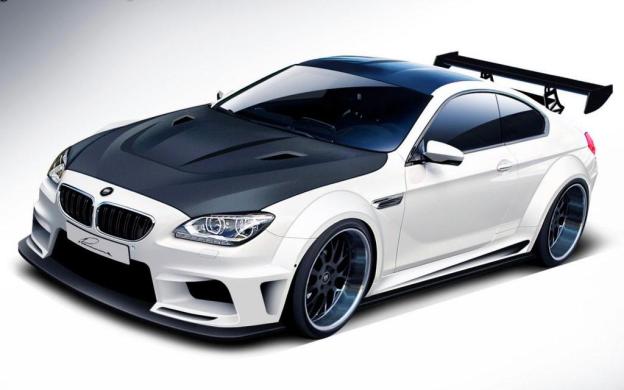 The newest generation of BMW’s 6 Series hasn’t been out long, but it is already getting plenty of attention from tuners. One company is upgrading the 640i Gran Coupe, and now the vaunted M6 coupe is going under the knife. A German company called Lumma Design is making the modifications, including a wide body kit that makes the car, dubbed CLR 6 M, look like a racer.
The newest generation of BMW’s 6 Series hasn’t been out long, but it is already getting plenty of attention from tuners. One company is upgrading the 640i Gran Coupe, and now the vaunted M6 coupe is going under the knife. A German company called Lumma Design is making the modifications, including a wide body kit that makes the car, dubbed CLR 6 M, look like a racer.
The most obvious deviations from the stock M6 are those extra-wide fenders, encircling 21-inch wheels with some serious backspacing. The M6 was already a good-looking car, but the wide body look gives it a whole new attitude.
That attitude seems to include fantasies of DTM or Le Mans GT Class racing. In addition to the widened fenders, the CLR 6 M has the scoops (in the front bumper, hood, side skirts, and rear bumper) and aerodynamic aids (front splitter, rear diffuser and wing spoiler) of a proper race car.
Lumma thought of something better than racing stripes to decorate the CLR 6 M. The carbon fiber hood, combined with the stock M6’s carbon fiber roof, form a streak of exposed carbon that contrasts nicely with the white bodywork in Lumma’s sketches.
The CLR 6 M definitely looks like a race car, but will it have the performance to back up those looks? With 552 horsepower and 500 pound-feet of torque, the stock M6 is already a serious performer. Lumma did not release any performance data for the CLR 6 M, but the company builds a custom X6 M, with the same 4.4-liter twin-turbocharged V8 as the M6, with 652 hp.
Lumma will also install a custom interior in the CLR 6 M. It features red and black two-tone trim, and a liberal dose of carbon fiber trim to match the exterior. Maybe Lumma would be better off stripping all of that out and installing a roll cage and fire extinguisher.
Tuning a high-end car like the M6 is tricky: it’s hard to improve on such a desirable car without going overboard. However, the Lumma CLR 6 M seems to strike the right balance. It dials up the attitude with racer looks that don’t make the car look like a monstrosity, and if the performance matches the company’s previous efforts, it won’t be a poseur.
Lumma has not put a price tag on the CLR 6 M, but expect it to cost significantly more than an M6’s $106,995 base price. Lumma hopes to begin turning M6s into CLR 6 Ms this fall after a public unveiling.
Editors' Recommendations
- BMW M bundles supercar-like performance into the X5 and the X6
- BMW continues to define the concept of style over substance with the 2020 X6



